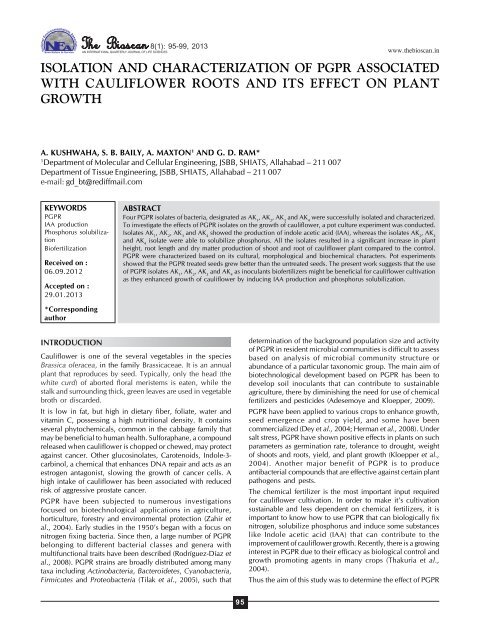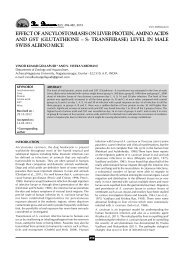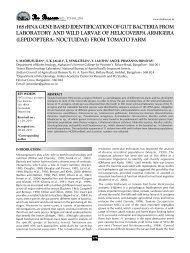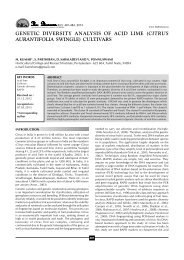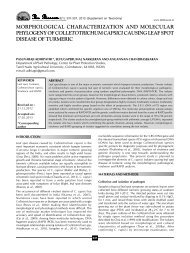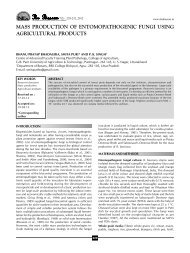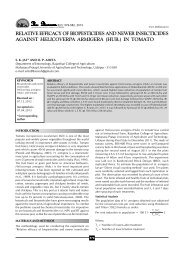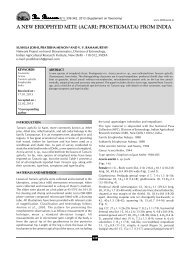Isolation and characterization of PGPR associated ... - THE BIOSCAN
Isolation and characterization of PGPR associated ... - THE BIOSCAN
Isolation and characterization of PGPR associated ... - THE BIOSCAN
You also want an ePaper? Increase the reach of your titles
YUMPU automatically turns print PDFs into web optimized ePapers that Google loves.
NSave Nature to Survive<br />
8(1): 95-99, 2013<br />
95<br />
www.thebioscan.in<br />
ISOLATION AND CHARACTERIZATION OF <strong>PGPR</strong> ASSOCIATED<br />
WITH CAULIFLOWER ROOTS AND ITS EFFECT ON PLANT<br />
GROWTH<br />
A. KUSHWAHA, S. B. BAILY, A. MAXTON 1 AND G. D. RAM*<br />
1 Department <strong>of</strong> Molecular <strong>and</strong> Cellular Engineering, JSBB, SHIATS, Allahabad – 211 007<br />
Department <strong>of</strong> Tissue Engineering, JSBB, SHIATS, Allahabad – 211 007<br />
e-mail: gd_bt@rediffmail.com<br />
KEYWORDS<br />
<strong>PGPR</strong><br />
IAA production<br />
Phosphorus solubilization<br />
Bi<strong>of</strong>ertilization<br />
Received on :<br />
06.09.2012<br />
Accepted on :<br />
29.01.2013<br />
*Corresponding<br />
author<br />
INTRODUCTION<br />
ABSTRACT<br />
Four <strong>PGPR</strong> isolates <strong>of</strong> bacteria, designated as AK 1 , AK 2 , AK 3 <strong>and</strong> AK 4 were successfully isolated <strong>and</strong> characterized.<br />
To investigate the effects <strong>of</strong> <strong>PGPR</strong> isolates on the growth <strong>of</strong> cauliflower, a pot culture experiment was conducted.<br />
Isolates AK 1 , AK 2 , AK 3 <strong>and</strong> AK 4 showed the production <strong>of</strong> indole acetic acid (IAA), whereas the isolates AK 2 , AK 3<br />
<strong>and</strong> AK 4 isolate were able to solubilize phosphorus. All the isolates resulted in a significant increase in plant<br />
height, root length <strong>and</strong> dry matter production <strong>of</strong> shoot <strong>and</strong> root <strong>of</strong> cauliflower plant compared to the control.<br />
<strong>PGPR</strong> were characterized based on its cultural, morphological <strong>and</strong> biochemical characters. Pot experiments<br />
showed that the <strong>PGPR</strong> treated seeds grew better than the untreated seeds. The present work suggests that the use<br />
<strong>of</strong> <strong>PGPR</strong> isolates AK 1 , AK 2 , AK 3 <strong>and</strong> AK 4 as inoculants bi<strong>of</strong>ertilizers might be beneficial for cauliflower cultivation<br />
as they enhanced growth <strong>of</strong> cauliflower by inducing IAA production <strong>and</strong> phosphorus solubilization.<br />
Cauliflower is one <strong>of</strong> the several vegetables in the species<br />
Brassica oleracea, in the family Brassicaceae. It is an annual<br />
plant that reproduces by seed. Typically, only the head (the<br />
white curd) <strong>of</strong> aborted floral meristems is eaten, while the<br />
stalk <strong>and</strong> surrounding thick, green leaves are used in vegetable<br />
broth or discarded.<br />
It is low in fat, but high in dietary fiber, foliate, water <strong>and</strong><br />
vitamin C, possessing a high nutritional density. It contains<br />
several phytochemicals, common in the cabbage family that<br />
may be beneficial to human health. Sulforaphane, a compound<br />
released when cauliflower is chopped or chewed, may protect<br />
against cancer. Other glucosinolates, Carotenoids, Indole-3carbinol,<br />
a chemical that enhances DNA repair <strong>and</strong> acts as an<br />
estrogen antagonist, slowing the growth <strong>of</strong> cancer cells. A<br />
high intake <strong>of</strong> cauliflower has been <strong>associated</strong> with reduced<br />
risk <strong>of</strong> aggressive prostate cancer.<br />
<strong>PGPR</strong> have been subjected to numerous investigations<br />
focused on biotechnological applications in agriculture,<br />
horticulture, forestry <strong>and</strong> environmental protection (Zahir et<br />
al., 2004). Early studies in the 1950’s began with a focus on<br />
nitrogen fixing bacteria. Since then, a large number <strong>of</strong> <strong>PGPR</strong><br />
belonging to different bacterial classes <strong>and</strong> genera with<br />
multifunctional traits have been described (Rodríguez-Díaz et<br />
al., 2008). <strong>PGPR</strong> strains are broadly distributed among many<br />
taxa including Actinobacteria, Bacteroidetes, Cyanobacteria,<br />
Firmicutes <strong>and</strong> Proteobacteria (Tilak et al., 2005), such that<br />
determination <strong>of</strong> the background population size <strong>and</strong> activity<br />
<strong>of</strong> <strong>PGPR</strong> in resident microbial communities is difficult to assess<br />
based on analysis <strong>of</strong> microbial community structure or<br />
abundance <strong>of</strong> a particular taxonomic group. The main aim <strong>of</strong><br />
biotechnological development based on <strong>PGPR</strong> has been to<br />
develop soil inoculants that can contribute to sustainable<br />
agriculture, there by diminishing the need for use <strong>of</strong> chemical<br />
fertilizers <strong>and</strong> pesticides (Adesemoye <strong>and</strong> Kloepper, 2009).<br />
<strong>PGPR</strong> have been applied to various crops to enhance growth,<br />
seed emergence <strong>and</strong> crop yield, <strong>and</strong> some have been<br />
commercialized (Dey et al., 2004; Herman et al., 2008). Under<br />
salt stress, <strong>PGPR</strong> have shown positive effects in plants on such<br />
parameters as germination rate, tolerance to drought, weight<br />
<strong>of</strong> shoots <strong>and</strong> roots, yield, <strong>and</strong> plant growth (Kloepper et al.,<br />
2004). Another major benefit <strong>of</strong> <strong>PGPR</strong> is to produce<br />
antibacterial compounds that are effective against certain plant<br />
pathogens <strong>and</strong> pests.<br />
The chemical fertilizer is the most important input required<br />
for cauliflower cultivation. In order to make it’s cultivation<br />
sustainable <strong>and</strong> less dependent on chemical fertilizers, it is<br />
important to know how to use <strong>PGPR</strong> that can biologically fix<br />
nitrogen, solubilize phosphorus <strong>and</strong> induce some substances<br />
like Indole acetic acid (IAA) that can contribute to the<br />
improvement <strong>of</strong> cauliflower growth. Recently, there is a growing<br />
interest in <strong>PGPR</strong> due to their efficacy as biological control <strong>and</strong><br />
growth promoting agents in many crops (Thakuria et al.,<br />
2004).<br />
Thus the aim <strong>of</strong> this study was to determine the effect <strong>of</strong> <strong>PGPR</strong>
A. KUSHWAHA et al.,<br />
strains that are compatible with cauliflower.<br />
MATERIALS AND METHODS<br />
<strong>Isolation</strong> <strong>of</strong> <strong>PGPR</strong> from cauliflower rhizosphere<br />
Sample collection<br />
Soil samples were collected from the rhizosphere <strong>of</strong> two monthold<br />
cauliflower plants. The rhizosphere was dug out with intact<br />
root system. The samples were placed in plastic bags <strong>and</strong><br />
stored at 4ºC.<br />
Bacterial isolation<br />
Ten grams <strong>of</strong> rhizosphere soil were taken into a 250mL <strong>of</strong><br />
conical flask <strong>and</strong> 90mL <strong>of</strong> sterile distilled water was added to<br />
it. The flask was shaken for 10min on a rotary shaker. One<br />
milliliter <strong>of</strong> suspension was added to 10mL vial <strong>and</strong> shaken<br />
for 2min. Serial dilution technique was performed upto 10-7 dilution. An aliquot (0.1mL) <strong>of</strong> this suspension was spread on<br />
the plates <strong>of</strong> Luria Bartany (LB) agar medium. Plates were<br />
incubated for 3 days at 28ºC to observe the colonies <strong>of</strong><br />
bacteria. Bacterial colonies were streaked to other LB agar<br />
plates <strong>and</strong> the plates were incubated at 28ºC for 3 days. Typical<br />
bacterial colonies were observed over the streak. Well isolated<br />
single colony was picked up <strong>and</strong> re-streaked to fresh LB agar<br />
plate <strong>and</strong> incubated similarly.<br />
Identification <strong>of</strong> isolates<br />
The bacterial strain was studied for cultural, morphological<br />
<strong>and</strong> biochemical characteristics based on Bergey’s Manual <strong>of</strong><br />
Systematic Bacteriology (Hoit et al., 1989).<br />
Cultural characteristics<br />
All the isolates were streaked on LB agar plates. After 3 days <strong>of</strong><br />
incubation, different characteristics <strong>of</strong> colonies such as growth,<br />
form <strong>and</strong> colour.<br />
Morphological characteristics<br />
The suspected organisms were subjected to Gram’s staining<br />
(Vincent, 1970). The bacteria which retained the primary stain<br />
called gram + ve while those that lost the crystal violet <strong>and</strong><br />
counter stained by safranin were referred as gram – ve.<br />
Biochemical <strong>characterization</strong><br />
Methyl Red test<br />
Tubes containing the sterilized MR –VP broth were inoculated<br />
with isolated bacterial strains <strong>and</strong> one tube as uninoculated<br />
comparative control. Then all the inoculated <strong>and</strong> uninoculated<br />
tubes were incubated at 37ºC for 48h. After 48h <strong>of</strong> incubation<br />
5 drops <strong>of</strong> methyl red indicator was added to each tube. When<br />
methyl red was added, it remained red which was indicative<br />
<strong>of</strong> positive test while turning <strong>of</strong> methyl red to yellow indicated<br />
the negative test.<br />
Hydrogen sulfide production test<br />
The inoculum was stab inoculated onto the SIM agar medium<br />
<strong>and</strong> incubated at 37ºC for 48h. Blackening <strong>of</strong> the culture<br />
medium indicated a positive test while no change in colour <strong>of</strong><br />
the medium indicated a negative test.<br />
Catalase test<br />
The hydrogen peroxide solution (2%) was added to the culture<br />
on a slide. The release <strong>of</strong> free oxygen bubbles indicated a<br />
96<br />
positive test.<br />
Casein Hydrolysis test<br />
The casein agar plate was streaked with the isolated organism<br />
in sterile condition. After that the plates were incubated at<br />
37ºC for 24-48h in an inverted position (Seeley <strong>and</strong><br />
V<strong>and</strong>emark, 1970). A clear zone surrounding the bacterial<br />
growth indicated the positive reaction for extracellular<br />
caseinase secretion while absence <strong>of</strong> clear zone indicated the<br />
negative reaction.<br />
Gelatin Hydrolysis test<br />
Gelatin agar medium was melted <strong>and</strong> cooled to 45-50ºC to<br />
pour into four sterile petri dishes. All the inoculated <strong>and</strong><br />
uninoculated (control) plates were incubated at 37ºC for 4 -7<br />
days. After incubation, plates were placed in refrigerator at<br />
4ºC for 24h. The incubated agar plates were flooded with<br />
mercuric chloride solution <strong>and</strong> the plates were allowed to<br />
st<strong>and</strong> for 5 to 10 minutes. Then plates were examined for<br />
clearing zone around the line <strong>of</strong> growth (Blazevic <strong>and</strong> Ederer,<br />
1975).<br />
Indole test<br />
The isolated organism was inoculated into tryptone broth the<br />
inoculated <strong>and</strong> uninoculated (control) tubes were incubated<br />
at 37ºC for 48h. After incubation, Kovac’s reagent was added<br />
to inoculated <strong>and</strong> control tubes. Development <strong>of</strong> cherry red<br />
colour at the top layer in the form <strong>of</strong> ring indicated the positive<br />
test while its absence indicated the negative test.<br />
Ammonia production test<br />
Fresh culture were inoculated into 10mL peptone water <strong>and</strong><br />
incubated for 48-72h at 37ºC. Nessler’s reagent (0.5mL) were<br />
added to each tube <strong>and</strong> development <strong>of</strong> yellow to brown<br />
colour was considered as positive test while no change in<br />
colour showed negative test (Cappuccino <strong>and</strong> Sherman ,<br />
1992).<br />
Phosphate solubilization test<br />
The bacterial isolates were inoculated into plates with sterilized<br />
Pikovskaya medium containing tricalcium phosphate <strong>and</strong><br />
incubated at 30ºC for 72h. Formation <strong>of</strong> clear zone around<br />
the colony indicated the phosphate solubilizaton by the<br />
bacteria (Pikovaskya, 1948).<br />
Growth under different temperature condition<br />
Cultures (24h old) <strong>of</strong> the isolated bacterial strains were streaked<br />
on LB Agar plates <strong>and</strong> incubated for 24-48h at 4ºC, 12ºC,<br />
28ºC <strong>and</strong> 37ºC. The change in growth <strong>and</strong> colour were<br />
observed.<br />
Pot experiment<br />
A soil sample was collected from the plots where cauliflower<br />
was produced for the past several years. The soil was sieved<br />
<strong>and</strong> mixed with thoroughly washed <strong>and</strong> dried s<strong>and</strong> in a<br />
proportion <strong>of</strong> 3:1 (soil: s<strong>and</strong>). The soil <strong>and</strong> s<strong>and</strong> mixture was<br />
then autoclaved for 15 mins at 121ºC. A h<strong>and</strong> full seeds <strong>of</strong><br />
cauliflower were surface sterilized with 0.5% (w/v) HgCl at 2<br />
room temperature <strong>and</strong> thoroughly washed with sterilized<br />
distilled water (Sirisk<strong>and</strong>arajah et al., 1993). Then 24h fresh<br />
isolated bacterial cultures were inoculated into 10mL LB broth<br />
<strong>and</strong> incubated for 24h at 37ºC <strong>and</strong> 12 sterilized seeds were<br />
added to each tube. After 24h <strong>of</strong> incubation, 5 seeds were<br />
sown to each <strong>of</strong> the 4 pots <strong>and</strong> control seeds were incubated
Figure 1: Gelatin hydrolysis <strong>of</strong> the<br />
Isolate AK1<br />
into sterilized distilled water. All pots were watered daily.<br />
Harvest occurred 4-5 weeks after beginning <strong>of</strong> the experiment.<br />
RESULTS<br />
Figure 2: Gelatin hydrolysis <strong>of</strong> the<br />
Isolate AK2<br />
Figure 5: Effect <strong>of</strong> <strong>PGPR</strong> isolates<br />
on growth <strong>of</strong> Cauliflower plants<br />
(A: Control, B: AK1 treatment, C:<br />
AK2 treatment, D: AK3 treatment,<br />
E: AK4 treatment)<br />
<strong>Isolation</strong> <strong>of</strong> <strong>PGPR</strong> strains from cauliflower rhizosphere<br />
To isolate the <strong>PGPR</strong> strains from cauliflower field soil samples<br />
were collected <strong>and</strong> inoculated on LB agar media. They were<br />
designated as AK , AK , AK <strong>and</strong> AK <strong>and</strong> were subjected to<br />
1 2 3 4<br />
cultural, morphological, biochemical <strong>characterization</strong>.<br />
Cultural characteristics<br />
The isolates AK , AK <strong>and</strong> AK were having smooth, irregular<br />
1 3 4<br />
97<br />
ISOLATION AND CHARACTERIZATION OF <strong>PGPR</strong><br />
Figure 3: Gelatin hydrolysis <strong>of</strong> the Figure 4. Gelatin hydrolysis <strong>of</strong> the<br />
Isolate AK3<br />
Isolate AK4<br />
<strong>and</strong> yellow colour colonies. AK isolate was regular, smooth<br />
2<br />
<strong>and</strong> light yellow colour colony. All the isolates were odourless<br />
(Table 1).<br />
Morphological characteristics<br />
The morphological characteristics <strong>of</strong> <strong>PGPR</strong> isolates widely<br />
varied. All the isolates produced rod shaped <strong>and</strong> were gram<br />
negative in reaction (Table 2).<br />
Biochemical characteristics<br />
Methyl- red tests<br />
In MR test, on addition <strong>of</strong> methyl red indicator the isolate AK2 <strong>and</strong> AK showed positive test. While the isolate AK <strong>and</strong> AK 4 1 3<br />
showed negative test.<br />
Hydrogen sulphide production test<br />
All the isolates AK , AK , AK <strong>and</strong> AK indicated the positive<br />
1 2 3 4<br />
test.<br />
Catalase test<br />
All the isolates AK , AK , AK <strong>and</strong> AK showed the catalase<br />
1 2 3 4<br />
positive test.<br />
Casein hydrolysis<br />
The AK isolate followed by AK <strong>and</strong> AK isolates were capable<br />
1 3 4<br />
<strong>of</strong> producing a clear zone surrounding the bacterial growth<br />
i.e. positive reaction for extracellular caseinase secretion while<br />
absence <strong>of</strong> clear zone was observed in the AK isolate i.e.<br />
2<br />
negative test for casein hydrolysis.<br />
Hydrolysis <strong>of</strong> gelatin, a protein (production <strong>of</strong> gelatinase)<br />
A clear zone was observed around the bacterial growth in<br />
presence <strong>of</strong> mercuric chloride solution in the inoculated petri<br />
plates demonstrating the proteolytic hydrolysis <strong>of</strong> gelatin i.e.<br />
positive reaction was shown by all the isolates (Fig.1- 4).<br />
Indole test<br />
Isolates AK was found to be good producer <strong>of</strong> IAA. On the<br />
3<br />
contrary, AK <strong>and</strong> AK were found to be medium producers <strong>of</strong><br />
2 4<br />
IAA in comparison to the weak producer isolate AK . 1<br />
NH production test<br />
3<br />
The isolates AK , AK , AK <strong>and</strong> AK were capable <strong>of</strong> producing<br />
1 2 3 4<br />
ammonia.<br />
Phosphate solubilization test<br />
The isolates AK , AK <strong>and</strong> AK were capable <strong>of</strong> solubilizing the<br />
2 3 4<br />
phosphorus while AK was not capable <strong>of</strong> solubilizing the<br />
1<br />
phosphorus.<br />
Growth under different temperature conditions<br />
The growth <strong>of</strong> isolates on LB agar plates varied in temperature
A. KUSHWAHA et al.,<br />
Table 1: Cultural characteristics <strong>of</strong> the Isolates<br />
Isolate Elevation Margin Colour Odour<br />
AK 1 Raised Smooth Yellowish Odourless<br />
AK 2 Raised Smooth Yolk yellowish Odourless<br />
AK 3 Raised Smooth Yellowish Odourless<br />
AK 4 Raised Smooth Yellowish Odourless<br />
Table 2: Morphological characteristics <strong>of</strong> the Isolates<br />
Isolate Shape Arrangement Gram reaction<br />
AK 1 Rod Staphylo -ve<br />
AK 2 Rod Strepto -ve<br />
AK 3 Rod Staphylo -ve<br />
AK 4 Rod Staphylo -ve<br />
(Table 4). The growth <strong>of</strong> all isolates was good in the temperature<br />
ranges <strong>of</strong> 28ºC to 40ºC. In addition, AK 3 <strong>and</strong> AK 4 isolates<br />
showed maximum growth at 40ºC.<br />
Pot experiment<br />
The highest root length (4 cm) was recorded in AK 4 among the<br />
four isolates. The <strong>PGPR</strong><br />
Isolates significantly affected the shoot length <strong>of</strong> cauliflower<br />
seedlings. Results reveal that shoot length increased in <strong>PGPR</strong><br />
treated plants over uninoculated control (Fig. 5). The highest<br />
shoot length (11.8cm) was recorded in AK 3 among the four<br />
isolates. The highest fresh weight (0.067gm) was recorded in<br />
AK 3 among the four isolates.<br />
A significant increase in dry matter <strong>of</strong> cauliflower seedlings<br />
was observed in response to <strong>PGPR</strong> isolates. The highest dry<br />
matter was recorded in isolate AK 3 (Table 5).<br />
Table 3: Biochemical characteristics <strong>of</strong> <strong>PGPR</strong> isolates<br />
Isolates AK1 AK2 AK3 AK4<br />
Methyl red test _ + _ +<br />
H S production test 2 + + + +<br />
Catalase test + + + +<br />
Casein hydrolysis test +++ _ + ++<br />
Gelatin hydrolysis test + + + +<br />
Indole tests + ++ +++ ++<br />
Phosphate sol.test _ + + +<br />
NH 3 test + + + +<br />
Identification Azospirillum PseudomonasAzotobacter<br />
Table 4: Growth under different temperature conditions<br />
Isolates Temperature<br />
4°C 12°C 28°C 40°C<br />
AK 1 _ _ ++ ++<br />
AK 2 _ _ ++ +<br />
AK 3 _ _ ++ +++<br />
AK 4 _ _ ++ +++<br />
Table 5: Effect <strong>of</strong> <strong>PGPR</strong> isolates on growth <strong>of</strong> cauliflower plant<br />
Isolate Root length Shoot Fresh Dry<br />
(cm) length weight weight<br />
(cm) (g) (g)<br />
Control 1.0 4.0 0.032 0.003<br />
AK 1 2.0 7.3 0.041 0.004<br />
AK 2 1.5 8.0 0.043 0.006<br />
AK 3 3.0 11.8 0.067 0.008<br />
AK 4 4.0 10.0 0.058 0.007<br />
98<br />
DISCUSSION<br />
The isolates AK 1 , AK 2 , AK 3 <strong>and</strong> AK 4 induced the IAA production.<br />
On contrary, AK 2 <strong>and</strong> AK 4 were found to be medium producer<br />
<strong>of</strong> IAA in comparison to the weak producer isolate AK 1 . It has<br />
been reported that IAA production by <strong>PGPR</strong> can vary among<br />
different species <strong>and</strong> it is also influenced by culture condition,<br />
growth stage <strong>and</strong> substrate ability (Mirza et al., 2001).<br />
Plant rhizosphere is known to be preferred ecological niche<br />
for soil microorganisms due to rich nutrient availability. Reports<br />
were available on Azotobacter spp. isolated from different<br />
sources showed IAA production (Gonzalez-Lopez et al., 2008;<br />
Jagnow, 1987; Nieto <strong>and</strong> Frankenberger, 1989). In the present<br />
study IAA production in Azotobacter isolates were in<br />
agreement with earlier reports. The ability <strong>of</strong> bacteria to<br />
produce IAA in the rhizosphere depends on the availability <strong>of</strong><br />
precursors <strong>and</strong> uptake <strong>of</strong> microbial IAA by plant. Growth<br />
promotion may be attributed to other mechanisms such as<br />
production <strong>of</strong> plant growth promoting hormones in the<br />
rhizosphere <strong>and</strong> other PGP activities (Arshad <strong>and</strong><br />
Frankenberger, 1993; Glick, 1995). Higher level <strong>of</strong> IAA<br />
production by Pseudomonas was recorded by other workers<br />
(Xie et al., 1996).<br />
Phosphorus is one <strong>of</strong> the major nutrients, second only to<br />
nitrogen in requirement for plants. Most <strong>of</strong> phosphorus in soil<br />
is present in the form <strong>of</strong> insoluble phosphates <strong>and</strong> cannot be<br />
utilized by the plants (Pradhan <strong>and</strong> Sukla, 2006). In<br />
comparison to non-rhizospheric soil, a considerably higher<br />
concentration <strong>of</strong> phosphate-solubilizing bacteria was<br />
commonly found in the rhizosphere (Raghu <strong>and</strong> MacRae,<br />
1966). The isolates AK 2 , AK 3 <strong>and</strong> AK 4 were able to solubilize<br />
phosphate in the rhizosphere soil.<br />
The <strong>PGPR</strong> isolates remarkably affected the germination <strong>of</strong><br />
cauliflower seeds. The highest seed germination was recorded<br />
when seeds were pretreated with AK 3 isolate. A large body <strong>of</strong><br />
evidence suggests that <strong>PGPR</strong> enhance the growth, seed<br />
emergence <strong>and</strong> crop yield (Dey et al., 2004; Kloepper et al.,<br />
2004; Kokalis-Burelle et al., 2006; Herman et al., 2008).<br />
REFERENCES<br />
Adesemoye, A. O. <strong>and</strong> Kloepper, J. W. 2009. Plant–microbes<br />
interactions in enhanced fertilizer-use efficiency. Applied Microbiology<br />
<strong>and</strong> Biotechnology 85: 1-12.<br />
Arshad, M. <strong>and</strong> Frankenberger, Jr. W. T. 1993. Microbial production<br />
<strong>of</strong> plant growth regulators. Marcel <strong>and</strong> Dekker, New York 307–347.<br />
Blezevic, D. J. <strong>and</strong> Ederer, G. M. 1975. Principles <strong>of</strong> biochemical<br />
tests in diagnostic microbiology, Wiley <strong>and</strong> Company, New York. 13-<br />
45.<br />
Cappuccino, J. G. <strong>and</strong> Sherman, N. 1992. Microbiology: A laboratory<br />
manual. The Benjamin/Comings Publishing Company, Inc., California.<br />
Dey, R., Pal, K. K., Bhatt, D. M. <strong>and</strong> Chauhan, S. M. 2004. Growth<br />
promotion <strong>and</strong> yield enhancement <strong>of</strong> peanut (Arachis hypogaea L.) by<br />
application <strong>of</strong> plant growth-promoting rhizobacteria. Microbiological<br />
Research 159: 371-394.<br />
Glick, B. R. 1995. The enhancement <strong>of</strong> plant growth by free living<br />
bacteria. Canadian J. Microbiology. 41: 109-114.<br />
Gonzalez-Lopez, J., Salmeron, V., Martinez-Toledo, M. V., Ballesteros,<br />
F. <strong>and</strong> Ramos-Herman, M. A. B., Nault, B. A. <strong>and</strong> Smart, C. D. 2008.<br />
Effects <strong>of</strong> plant growth promoting rhizobacteria on bell pepper
production <strong>and</strong> green peach aphid infestations in New York. Crop<br />
Protection. 27: 996-1002.<br />
Hoit, J. G., Krieg, H. R., Sneath, P. H. A., Stanley, J. T. <strong>and</strong> William,<br />
S. T. 1989. Bergey’s Manual <strong>of</strong> Systematic Bacteriology. William <strong>and</strong><br />
Wilkin Publisers, Baltimore, pp. USA 1-4.<br />
Jagnow, G. 1987. Inoculation <strong>of</strong> cereal crops <strong>and</strong> forage grasses with<br />
nitrogen fixing rhizosphere bacteria:Possible causes <strong>of</strong> success <strong>and</strong><br />
failure with regard to yield response – A review. Z. Pflanzenernnaehr.<br />
Bodenkd. 150: 361-368.<br />
Kloepper, J. W., Ryu, C. M. <strong>and</strong> Zhang, S. 2004. Induced systemic<br />
resistance <strong>and</strong> promotion <strong>of</strong> plant growth by Bacillus spp.<br />
Phytopathology. 94: 1259-1266.<br />
Kokalis-Burelle, N., Kloepper, J. W. <strong>and</strong> Reddy, M. S. 2006. Plant<br />
growth promoting rhizobacteria as transplant amendments <strong>and</strong> their<br />
effects on indigenous rhizosphere microorganisms. Applied. Soil<br />
Ecology. 31: 91-100.<br />
Mirza, M. S., Ahmad, W., Latif, F., Haurat, J., Bally, R., Narm<strong>and</strong>, P.<br />
<strong>and</strong> Malik, K. A. 2001. <strong>Isolation</strong> <strong>and</strong> partial <strong>characterization</strong> <strong>and</strong> the<br />
effect <strong>of</strong> Plant Growth Promoting Bacteria (PGPB) on micropropagated<br />
sugarcane invitro. Plant Soil. 237: 47-54.<br />
Nieto, K. F. <strong>and</strong> Frankenberger, W. T. 1989. Biosynthesis <strong>of</strong> cytokinins<br />
produced by Azotobacter chroococcum. Soil Biology <strong>and</strong><br />
Biochemistry. 21: 967-972.<br />
Pikovskaya R. I. 1948). Mobilization <strong>of</strong> phosphates in soil in<br />
connection with the vital activities <strong>of</strong> some microbial species.<br />
Microbiology. 17 : 362-370.<br />
Pradhan, N. <strong>and</strong> Sukla, L. B. 2006. Solubilization <strong>of</strong> inorganic<br />
phosphates by fungi isolated from agriculture soil. African J.<br />
Biotechnology. 5: 850-854.<br />
Raghu, K. <strong>and</strong> MacRae, I. C. 1966. Occurrence <strong>of</strong> phosphatedissolving<br />
microorganisms in the rhizosphere <strong>of</strong> rice plants <strong>and</strong> in<br />
submerged soils. J. Applied Bacteriology. 29: 582-586.<br />
99<br />
ISOLATION AND CHARACTERIZATION OF <strong>PGPR</strong><br />
Rodríguez-Díaz, M., Rodelas-Gonzalés, B., Pozo-Clement, C.,<br />
Martínez-Toledo, M. V., González-López, J. 2008. A review on the<br />
taxonomy <strong>and</strong> possible screening traits <strong>of</strong> plant growth promoting<br />
rhizobacteria. In: I. Ahmad, J.Pichtel, J., S. Hayat (eds). Plant-Bacteria<br />
Interactions: Strategies <strong>and</strong> Techniques to Promote Plant Growth.<br />
Wiley-VCH Verlag GmbH <strong>and</strong> Co. KGaA, Weinheim, Germany. pp.<br />
55–80.<br />
Seeley, H. W. <strong>and</strong> V<strong>and</strong>emark, P. J. 1970. Microbes in action: A<br />
laboratory manual <strong>of</strong> microbiology, D. P. Tarapo Revale Sons <strong>and</strong><br />
Company Ltd., Bombay. pp. 86-95.<br />
Sirisk<strong>and</strong>arajah, S., Kennedy, I. R., Yu, D. <strong>and</strong> Tchan, Y. 1993. Effect<br />
<strong>of</strong> plant regulators on acetylene- reducing associations between<br />
Azosprillum brasilense <strong>and</strong> wheat. Plant Soil. 153: 165-178.<br />
Tilak, K. V. B. R., Ranganayaki, N., Pal, K. K., De, R., Saxena, A. K.,<br />
Nautiyal, C. S., Mittal, S., Tripathi, A. K. <strong>and</strong> Johri, B. N. 2005.<br />
Diversity <strong>of</strong> plant growth <strong>and</strong> soil health supporting bacteria. Current<br />
Science India. 89: 136-150.<br />
Thakuria, D., Talukdar, N. C., Goswami, C., Hazarika, S., Boro, R.<br />
C. <strong>and</strong> Khan, M. R. 2004. Characterization <strong>and</strong> screening <strong>of</strong> bacteria<br />
from the rhizosphere <strong>of</strong> rice grown in acidic soils <strong>of</strong> Assam. Curent<br />
Science. 86: 978-985.<br />
Vincent, J. M. 1970. A manual for the practical study <strong>of</strong> the root<br />
nodule bacteria. Blackwell Scientific publications Oxford <strong>and</strong><br />
Edinburgh. pp. 1-3.<br />
Xie, H., Pasternak, J. J. <strong>and</strong> Glick, B. R. 1996. <strong>Isolation</strong> <strong>and</strong><br />
<strong>characterization</strong> <strong>of</strong> mutants <strong>of</strong> plant growth promoting rhizobacterium<br />
Pseudomonas putida GR 12-2 that over produce indoleacetic acid.<br />
Current Microbiology. 32: 67-71.<br />
Zahir, A. A., Arshad, M. <strong>and</strong> Frankenberger, W. T. 2004. Plant growth<br />
promoting rhizobacteria: applications <strong>and</strong> perspectives in agriculture.<br />
Advances Agronomy. 81: 97-168.
100


